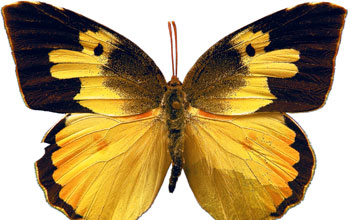Multimedia Gallery
What a Butterfly Sees (Image 9)
A male southern dogface (Colias cesonia) butterfly, as it appears to the human eye. This species has a wingspan of about 5 centimeters and is common throughout southern North America. Ron Rutowski, an entomologist and behavioral ecologist at Arizona State University, is studying butterfly vision.
More about this image
Butterflies are very nearsighted. While they can spot color and conspecifics, they cannot recognize patterns. In addition, their vision is monocular, not binocular like humans, making them unable to assess depth or distance in the same way we can. However, nature has made up for this in other ways. Some species of butterflies, like the empress Leilia (Asterocampa leilia), have a visual field of about 344 degrees on the horizontal plane--only 16 degrees short of seeing all the way around its body. And vertically it is almost a full 360 degrees. The average human has a visual field of only 190 degrees. This wide field of vision helps protect them from predators, particularly birds. Most butterfly species have visual fields that are equally impressive.
Although butterflies cannot see detailed patterns, some species do rely on colors, particularly colors that are not visible to human eyes, to find and consider a mate. Rutowski found that virgin females of the orange sulfur (Colias eurytheme) species, are able to visually assess the relative age and fitness of competing males using ultraviolet (UV) scales on the males' wings, and receptors in the female's eyes. These receptors allow the females to see UV wavelengths. Missing scales indicate aging and reduce a male's ability to seduce a mate. This research was supported in part by the National Science Foundation.
To learn more about this research, see "An Eye for Survival," in the ASU Research Magazine. (Date of Image: 2002) [One of 10 related images. See Next Image.]
Credit: Ron Rutowski, Ph.D.
Special Restrictions: The owner has restricted the use of this image. The credit line must appear with all uses. Permission is granted to use the image for personal, educational and nonprofit/non-commercial purposes only and only after sending an email notifying your intent to use to r.rutowski@asu.edu. Permission to use this image in any other manner is prohibited without prior permission from the owner. Conact ASU Research Magazine by phone, (480) 965-1266, or by email, cstorad@asu.edu.
Images and other media in the National Science Foundation Multimedia Gallery are available for use in print and electronic material by NSF employees, members of the media, university staff, teachers and the general public. All media in the gallery are intended for personal, educational and nonprofit/non-commercial use only.
Images credited to the National Science Foundation, a federal agency, are in the public domain. The images were created by employees of the United States Government as part of their official duties or prepared by contractors as "works for hire" for NSF. You may freely use NSF-credited images and, at your discretion, credit NSF with a "Courtesy: National Science Foundation" notation.
Additional information about general usage can be found in Conditions.
Also Available:
Download the high-resolution JPG version of the image. (2.5 MB)
Use your mouse to right-click (Mac users may need to Ctrl-click) the link above and choose the option that will save the file or target to your computer.



